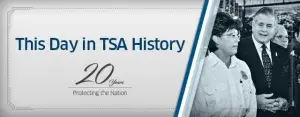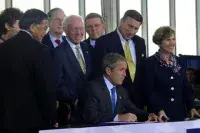
This Day in TSA History: November 19, 2001
The Aviation and Transportation Security Act and the birth of TSA.
On this day, November 19, 2001, former President George W. Bush signed the Aviation and Transportation Security Act (ATSA), forever changing air travel as we once knew it. But what was air travel like before 9/11 and ATSA, and what actually changed?
Before 9/11, airport security was outsourced to private contractors and was much less stringent than TSA’s current standards. Travelers passed through metal detectors, and friends and family could accompany them to the gate, delaying hugs and goodbyes to the last possible moment. You could bring blades up to four inches (or box cutters) on board as they were not considered menacing according to an FAA manual. Most local laws didn’t prohibit them. No long checkpoint lines.
Traveling was easier.
As security measures evolved with the discovery of new threats, travelers were required to remove items from their bags and take out their computers for scanning. They were asked to remove belts and shoes, and all liquids, gels and aerosols over 3.4 ounces were prohibited except mother’s milk. Some of these rules mystified unknowing passengers. Travelers were required to arrive earlier and stand in longer lines. The new rules were almost daily and forever changing at random; or so it seemed.
The longer lines eventually resulted into the fee-based “trusted traveler programs” like TSA PreCheck® and Global Entry. But these new conveniences came at a price. Fingerprints were gathered along with basic information such as where you lived and your work history. Some feared for their privacy without thinking about the personal information required for a credit card, cable service or a driver’s license.
Recently, TSA moved into the era of “touchless screening,” accelerated by the COVID-19 pandemic. TSA installed kiosks with facial recognition technology to check boarding passes and IDs, freeing Officers to perform other duties. We continue to evolve our processes and equipment to meet the ongoing threats.
We have also enthusiastically entered into surface transportation – mass transit, passenger and freight rail, highway and motor carrier, pipeline and maritime security. It is not uncommon to find TSA Officers, VIPR teams and other DHS elements at Metro stations, commercial bus stops, and Amtrak stations. Most recently, we strengthened our cyber teams to meet ongoing infrastructure threats. Yet, airline travel was our founding focus.
With the many different ways chaos could break out on airplanes since 9/11, it usually doesn’t. The act of getting into a metal tube and moving through the air at 30,000 feet and 530 miles per hour, crossing states, continents and oceans is a common 21st century event, regardless of how arduous it has become.
The TSA of 2002 has evolved into the flexible and agile organization of today, meeting the ever-changing security challenges of the nation’s transportation systems with a team of dedicated professionals who say,
“Not on my watch.”

